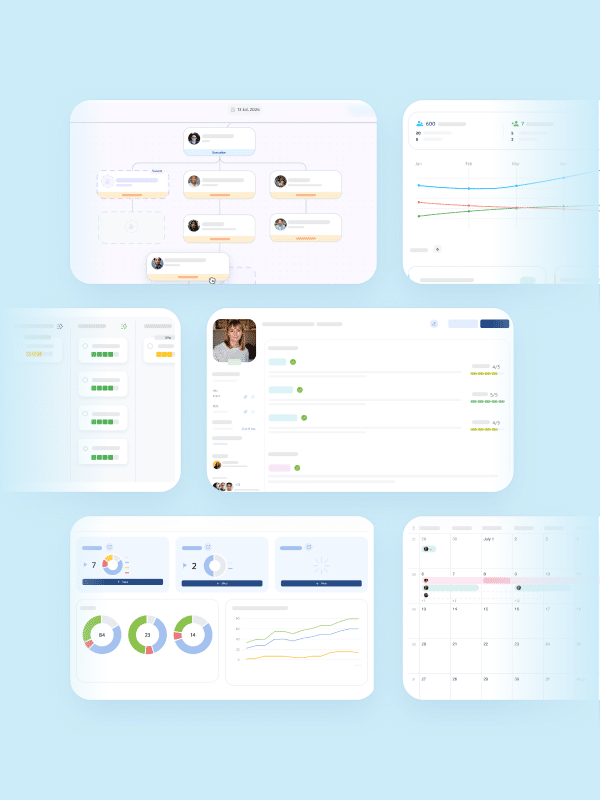Performance management has changed a lot since the early days when it was first introduced during the industrial revolution. Since then, performance management has come a long way, but there remain many issues with older models of performance management.
Organizations of all sizes are reinventing how they think about the future of performance management in a faster, more technological world.
To have a high-performing team, it’s important to identify future trends in performance management to lead employees effectively and keep them engaged.
Here we’ll cover what’s driving the future of performance management, what to expect, and how you can transition your organization to a modern performance management system with the right tools and software.
What is performance management?
Performance refers to an individual’s ability to perform a specific function and is linked to productivity. Performance management describes the method by which organizations manage the performance of their employees.
The idea of performance management began in the bleak days of the industrial revolution when factory workers were expected to accomplish a specific number of (often repetitive) tasks. Employees were often treated like machines, and the focus was always on the labor output instead of the people performing the tasks.
While the term ‘performance management’ remains the same, the way employees are viewed by organizations has changed considerably. Even now, performance management is undergoing a huge transformation.

Reflections from an HR expert
Today, employees are more informed than ever before. If people feel their work is unappreciated or if they don’t feel engaged at work, they know that there are other companies that will offer them those things.
The problem with old models
The outdated performance management model of annual reviews provides limited data from which to evaluate an employee and uses financial rewards and punishments to hold people accountable. This often results in employees not feeling recognized for their daily efforts and, in many cases, experiencing burnout.
But today, employees are more informed than ever before. If people feel their work is unappreciated or if they don’t feel engaged at work, they know that there are other companies that will offer them those things.
Unlike the early days of the industrial revolution, employees are now considered in many companies to be the heart and soul of an organization. This means that organizational structures have changed in regard to leadership and management. Organizations are evolving to implement more agile team structures with frequent check-ins and goal-setting.
Current State of Performance Management
Despite the problems with the old models used for performance management, many organizations are looking at new ways to evaluate employee performance while at the same time making the output better than before.
Companies like Google, Adobe, IBM, and others are taking a new approach toward performance management. Several ways they are making changes is by:
- Collecting more data through tools that automate performance analysis
- Taking more of a holistic approach toward feedback
- Emphasizing the progress of the individual instead of the entire team output.
We’ll go into these more in the next section.

Browse our webinar library!
We have a number of webinars about different HR related topics available to watch whenever you want.
What performance is shifting toward
Here are the future trends in performance management we can expect to see:
Rethinking ‘what is performance?’
The very meaning behind ‘performance’ is being reevaluated by many organizations. Does it equate to output numbers and scorecards? Or does it mean progress and overall contribution? It’s important to ask questions to decide what performance means within your own organization.
Instead of focusing on quantity-based measurements, try placing more emphasis on quality-based measurements such as:
- Whether an employee feels that they serve an important purpose (a key indicator of engagement)
- How well an employee works within the larger team
- Whether employees feel listened to and supported in their personal career goals
1:1 team talks
We can expect to see annual appraisals of performance shift to more informal, weekly check-ins between a manager and employee. Companies like Google, Microsoft, and IBM have already implemented these structures in their organizations.
Holding regular, 1 to 1 talks is becoming an essential way for many companies to facilitate a positive, productive working environment. Read more about this future trend of performance management and how to implement it into your organization.
Collecting appropriate data
Instead of using limited data collected just once a year during an annual appraisal, using a tool that can collect a larger amount of data more frequently will soon become the norm.
There are Software programs made for modern-thinking companies that can automate the data collection and analysis process. This leaves managers with more time to coach their teams instead of collecting and inputting data points. It also allows for performance evaluations to draw information from a wealth of data rather than just two to three data points.
The quality of the data itself will also be improved through this process, and will only continue to get better as AI and machine learning start playing a larger role in the future of performance management.
More ‘coach’ and less ‘boss’
Because attitudes in the workplace are changing to see employees as an organization’s biggest asset, managers will be expected to become more like coaches to their employees and less like bosses. To understand the difference, here are the characteristics of a ‘boss’:
- Dictating expectations
- Spending a lot of their time speaking
- Dealing with surface problems by taking the quickest solution
- Giving feedback without asking employees questions regarding goals or attitudes toward the workplace
The characteristics of a ‘coach’ are the following:
- Establishes expectations together with the employee
- Spends most of their time listening
- Gets to the root of a problem to come up with an effective solution
- Communicates frequently and openly
- Is open to being held accountable and receiving feedback
Employee development
Today, employees have more skills to bring to the table than ever before. They not only want to put those skills to good use, but they want to continue developing their skills. In the future and even now, simply showing up to work for a paycheck isn’t enough for employees. People want to be engaged at work and feel like they have a purpose in what they’re doing for an organization.
When managers can effectively step into that ‘coach’ role, and treat employees like a valuable asset, performance management shifts to focus on continued professional development.
360 Feedback
Many companies are adapting to a 360 feedback model, which offers more continuous, real-time feedback. What’s different about 360 feedback is that it includes feedback from coworkers, mentors, and other people involved in working with an individual as opposed to just the manager.
You can learn more about 360 feedback and how to implement it into your organization here.
Heartpace is already there
Heartpace is heavily invested in the future of performance management, which is why we’ve created a robust tool to help organizations collect data, perform talks, set and achieve goals, and implement effective performance management strategies.
While making the above changes outlined may require some work on the part of an organizations’ part, it will all lead to a happier work environment with high achievements. Our software can help you get there faster. Learn about our product and see what we can offer you today.

Do you want to see more?
Book a demo here to see Heartpace HR system
Explore more posts
Want to keep updated?
Subscribe to our blog posts, news and webinars here. We promise that we won’t overwhelm you with emails, nor will we never ever give your email address to anyone else!








